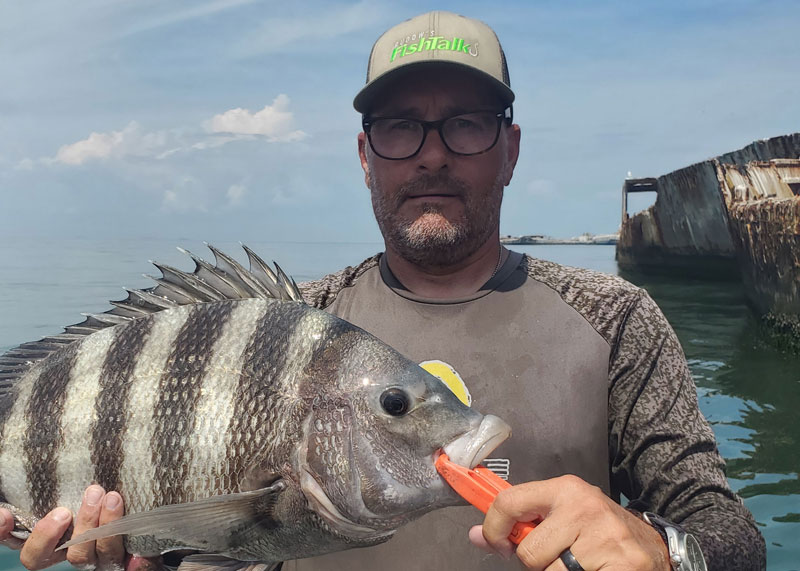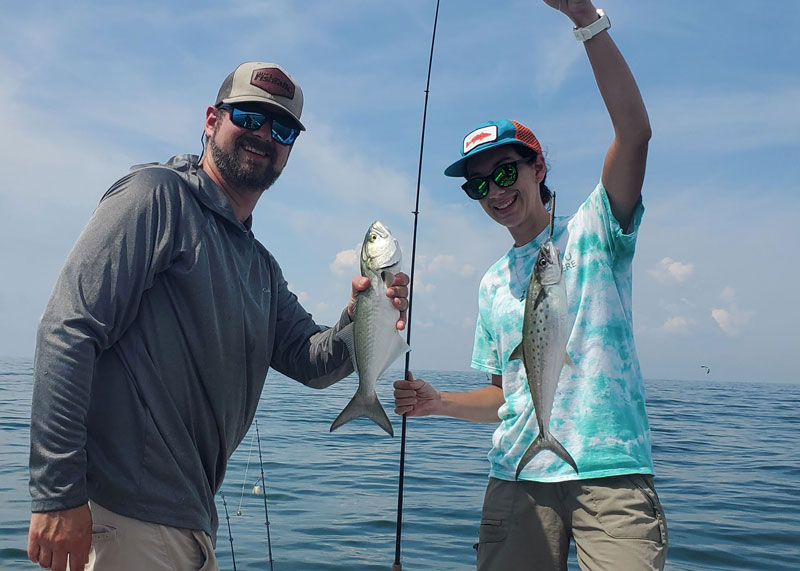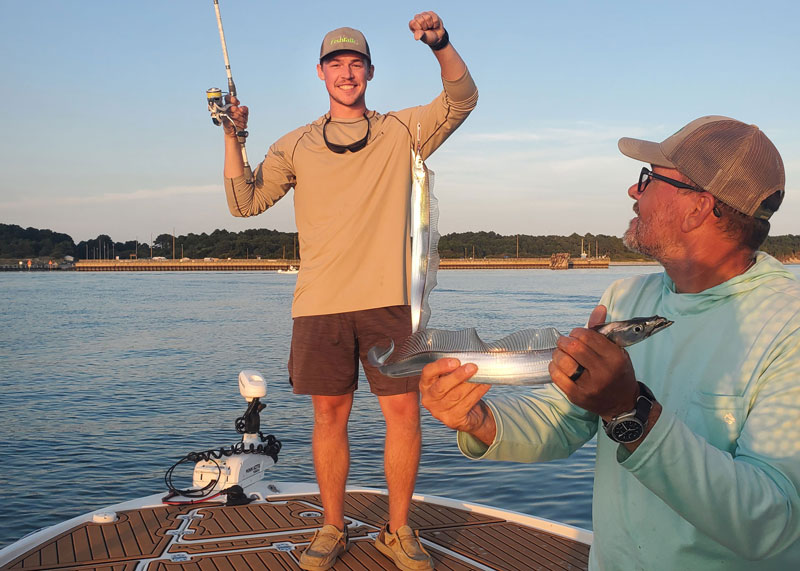Fishing at the CBBT always gets the headlines, which is no wonder since it holds the most diverse mix of utterly epic fisheries of any one hotspot in the entire Chesapeake Bay—in fact, one could argue that in a number of ways it’s one of the best fishing hotspots on the entire East Coast of the United States. But for many anglers it’s also a tough area to access. It can get mighty rough where the open Atlantic meets the Bay, and with over 17 miles of bridge-tunnel complex, there’s an awful lot of water to cover. Sitting in the shadow of the CBBT, however, there’s a not-so-hidden gem of a hotspot that’s accessible by just about anyone: Kiptopeke State Park.

The park has something for everyone, and a whole lot to love for anglers. There are cabins, campgrounds, a boat ramp, a fishing pier, hiking and biking trails, and both swimming and fishing beaches. The park is open for angling 24/7, the park office is open 8 a.m. to 4 p.m. Monday through Friday with varying seasonal hours on weekends, and there’s a camp store open 9 a.m. to 5 p.m. Friday through Sunday (May through October). And there are fish to be caught here. Lots and lots and lots of fish.
Fishing Kiptopeke From Shore
Shorebound anglers will discover some of the best potential for hooking into megafish—and lots of fish— on the fishing pier. It’s open 24 hours and is lighted, and some nights fish will swarm in the illuminated area. You can catch just about anything swimming in either the Bay or the Atlantic here: bottom fish like spot, croaker, and flounder; trophy sportfish like bull red drum or monster black drum; toothy predators like sharks and ribbonfish; free-swimmers including bluefish and Spanish mackerel—the list goes on and on.
Sharpies fishing here will often set out one baited rod with a top-and-bottom rig or a fishfinder rig to target bottom fish of one sort or another, while actively casting a second rod with offerings like Gotcha plugs or spoons. Baits can run the gamut with squid strips or bloodworms for the panfish and crab chunks or cut mullet and bunker for larger predators. Savvy anglers might also try casting a bottom rig baited with bloodworm or Fishbites to catch small fish like spot, which then go right onto the hook of a larger rig to be livelined for hungry predators.
Anglers can also hit the beach and try some surf casting, but be sure to head for the south beach area because the north beach is reserved for swimmers. Most people would probably argue that the pier fishing is better than on the beach, especially at night when the lights often pull in hordes of fish. But fishing the beach is also bound to be a bit more relaxing as the pier is quite popular and at times can get rather crowded.
Fishing Kiptopeke by Kayak
One of the best things about fishing here is the concrete ships. Nine of these ships, which were built during World War II when steel was in high demand, were sunk to create a breakwater. Today they sit in 12’ to 25’ of water about 350 yards from the boat ramp and fishing pier. So they’re a short pedal or paddle away, and thanks to their north/south orientation, there’s almost always sheltered water to be found on one side or the other. And they hold fish—lots and lots of fish—so they’re a favorite target for kayak anglers.

Many people will fish right up close to the ships, and especially in the gaps between their bows and sterns where water rushes between them, to target species like sheepshead, redfish, and flounder. And in this case kayak anglers have an advantage over the guys in boats since they can get right next to the structure and keep their baits tight to the strike zone. Stick with sand fleas or crab baits for the sheepshead and reds or drift minnow and jig bottom for the flounder. Put down a baited top-and-bottom rig and you’ll catch a mix of croaker, spot, roundhead (kingfish) and weakfish, next to and all around the ships.
When you’re getting tortured by tiny sea bass and other mini-fish (which can be a serious issue at the ships), try moving off the structure a bit and fish the troughs and holes around it. Up-sizing baits or switching to baits the tiny critters can’t grab easily (like fiddlers) sometimes helps, too.
Trolling can also be very effective here. Pulling small spoons or swimming plugs high in the water column is likely to produce an abundance of Spanish mackerel, bluefish, and cutlassfish. Keep an eye out for birds because often a school of fish will start breaking water and our feathered friends will give away its location. If it’s calm enough to get outside of the ships note that happening upon a cobia becomes very possible, as sometimes schools of bait stack up in the area and bring them into the trough just west of the ships.

Fishing Kiptopeke by Boat
Everything we just talked about that applies to the kayak guys applies to boat anglers, too. Of course, those with a boat have a bit more flexibility to expand their options. If flocks of birds are popping up and moving around you can chase them, or you can point the bow for distant horizons and make way for the CBBT and all the opportunities found there. You can also run for the open Bay where sight-fishing for cobia is often hot. Or from here it’s a quick hop to the Cabbage Patch reef, just a few miles to the west, where you can target species attracted by structure with less competition than is usually found at the concrete ships.
While the temptation to head for different destinations can be inescapable, remember that the fishing at Kiptopeke can be utterly fantastic. More than a few times boat anglers have launched at this location, run here, run there, and run everywhere, then returned to the concrete ships and caught more fish a few hundred yards from the ramp than they did anywhere else. And if you’re returning in the evening, remember that those pier lights are quite strong and bring a lot of fish into the area. After the sun has set you can park the boat well beyond casting range of the pier, set out lights of your own, and will likely have swarms of fish surrounding you in short order.
Feeling Friendly?
Remember that Kiptopeke is an incredibly popular, well-known fishing destination, so you need to expect to be fishing around plenty of other anglers regardless as to whether you’re on shore, on the pier, kayaking, or going by boat. During the summer whenever the weather is decent there will be plenty of lines in the water even during the middle of the week. On weekends you can expect a serious crowd. If you want a spot all to your own, either fish very early or very late in the day during the middle of the week, come during the off-season, or choose another destination.

That said, there’s plenty of room here for everyone. The range of productive waters is expansive, and the fish are often shockingly plentiful. Sometimes it’s impossible to go 10 minutes without getting a bite from some sort of finned critter, and you really never know just what that critter will be. If you haven’t tried fishing Kiptopeke yet give this hotspot a shot. In many ways, one could argue that it’s one of the very best hotspots on the entire East Coast of the United States—right behind that big bridge-tunnel complex that overshadows it.